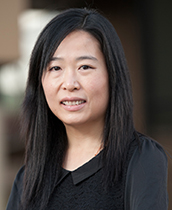EECS Department Colloquium Series
Engineering Near-field Interactions with Body for Powering
Bioelectronic Medicines 
 |
Wednesday, September 17, 2014 Ada Poon |
ABSTRACT:
Miniaturized electronics, when placed inside the body, can wirelessly
monitor and modulate internal activity and thus hold promise as a new class
of treatments for disorders. The development of such bioelectronic
medicines requires wireless interfaces that are less than a few millimeters
in size and operate deep in a complex electromagnetic environment. In this
talk, I will describe a new method for electromagnetic energy transfer that
exploits near-field interactions with biological tissue to wirelessly power
tiny devices anywhere in the body, including the heart and the brain. I
will discuss engineering and experimental challenges to realizing such
interfaces, including a pacemaker that is smaller than a grain of rice and
a fully internalized neuromodulation platform. These devices can act as
bioelectronic medicines, capable of precisely modulating local activity,
that may be more effective treatments than drugs, which act globally
throughout the body.
BIOGRAPHY:
Ada was born and raised in Hong Kong. She received her B.Eng degree from
the EEE department at the University of Hong Kong and her Ph.D. degree from
the EECS department at the University of California at Berkeley. Her
dissertation attempted to connect information theory with electromagnetic
theory so as to better understand the fundamental limit of wireless
channels. Upon graduation, she spent one year at Intel as a senior research
scientist building reconfigurable baseband processors for flexible radios.
Afterwards, she joined her advisor's startup company, SiBeam Inc.,
architecting Gigabit wireless transceivers leveraging 60-GHz CMOS and MIMO
antenna systems. After two years in industries, she returned to academic
and joined the faculty of the ECE department at the University of Illinois,
Urbana-Champaign. Since then, she has changed her research direction from
wireless communications to integrated biomedical systems. In 2008, she
moved back to California and joined the faculty of the Department of
Electrical Engineering at Stanford University. She is a Terman Fellow at
Stanford University. She received the Okawa Foundation Research Grant in
2010 and NSF CAREER Award in 2013.
| Return to EECS Joint Colloquium |

